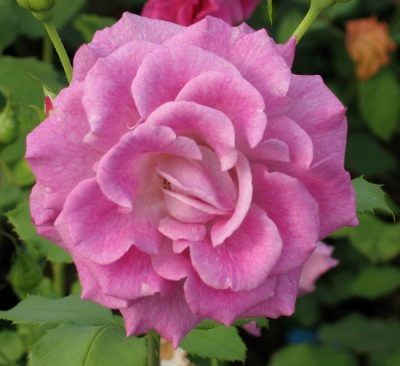
- Authors: Dorieux
- Name synonyms: Melodie Parfumee, Violette Parfumee, Melody Parfum, Violet Parfum
- Breeding year: 1995
- Group: tea-hybrid
- The main color of the flower: pink, lilac, purple
- Flower shape: high center
- Flower size: large
- Diameter, cm: 9-10
- Flower type by number of petals: medium terry
- Scent: damask rose
You can plan and arrange a flower bed, front garden or a small rose garden yourself, if you responsibly approach the choice of pink varieties that go well with each other, as well as with other plants. The hybrid tea rose Violet Perfume of French selection will bring bright colors to the flower garden.
Breeding history of the variety
Rose Violet Perfume appeared in 1995 thanks to the work of French breeders of the Francois Dorieux company. The result is a cross between two varieties Dioressence and Stephens Big Purple. You can grow pink shrubs in almost any region of Russia. The exception is the Urals and Siberia, where the temperature indicator drops below -23 degrees. The pink look is especially popular among gardeners of the Central region of the Russian Federation.
Description of the variety
The French rose is a vigorous plant that grows up to 120-150 cm in height in a favorable environment. The bush has erect and strong stems, abundant thickening of medium-sized toothed dark green leaves with a pronounced gloss, as well as a developed root system. The shoots of the plant are rarely covered with sharp thorns. Outwardly, the bush seems to be rounded due to lateral processes. In diameter, the bush is gaining about 90-100 cm.
On each stem, from 1 to 5 large flowers are formed. Roses can be located singly and in small-flowered inflorescences.
Advantages and disadvantages
The flower of incredible beauty is endowed with many advantages: abundant and long flowering (about 4 months), an average immune system, tolerance to rain, resistance to return frosts in spring, resistance to the scorching sun, pronounced aroma. Among the shortcomings, one can emphasize vulnerability to black spot and insufficient frost resistance, which does not allow growing a rose in the Urals or Siberia.
Flowering features
The variety belongs to the re-flowering species. During the flowering period, which begins at the end of June and ends in September, the bush is abundantly covered with large delicate roses. Dark purple goblet buds sit firmly on strong stems. Dissolving, neat, large semi-double flowers appear, consisting of 30-40 velvety petals. The roses open quite large - up to 9-10 cm in diameter, less often flowers are 14-15 cm. The color of the flowers is very unusual and beautiful - from pink-lavender to purple.
The characteristic feature of the pink variety is its intense aroma, manifested by spicy notes, complemented by citrus and violets. Roses smell as brightly as possible in the evening.
Use in landscape design
The rose is fragrant, so it is often planted around a garden pavilion. The entrance is decorated with French roses. Flowers are grown both separately and in an ensemble with other plants. Rose bushes look harmoniously with cotoneaster, mock orange, yellow acacia.
In addition, the rose looks perfect in combination with dwarf juniper, spruce and thuja. By planting bushes less than 100 cm away, you can create a hedge. Many people grow a variety for cutting, since the roses stand perfectly in a vase, without losing their freshness, beauty and aroma.
Landing
Planting is carried out both in spring and autumn.Due to the good tolerance of temperature fluctuations, the French rose is planted in April. For autumn planting, the end of September - early October is considered the best time. The site should be leveled, sunny, warm, protected from cold winds and drafts. It should be noted that the plant can develop in light shade conditions. The occurrence of groundwater must be deep.
Most comfortable for rose bushes in fertile, light, breathable soils with a good lime content. The soil should not be too acidic and waterlogged. Light loams enriched with nutrients will be optimal.
Growing and care
Before planting, pits 40x40 cm in size are prepared, observing a distance between plantings of 90-100 cm. Humus mixed with garden soil is introduced into each hole, drainage is made from pebbles, and then the seedlings are planted so that the grafting site is 2-3 cm higher than the soil At the end of the procedure, water is plentifully with warm water and the soil is tamped. The final stage is mulching with peat, straw and other materials.
The cultivation technique is simple - regular watering. Weeding and loosening the soil, applying top dressing, sanitary pruning and bush formation, disease prevention and shelter for the winter.
Watering and feeding
The rose needs weekly watering (1 adult bush requires 10-15 liters of settled water). During dry periods, watering is doubled. Fertilizers are applied three times per season. In the spring, nitrogen-containing complexes are introduced, and during the flowering period, potassium salt and superphosphates. In addition, wilted flowers should be removed in time.
Pruning
Pruning is performed every season, removing frozen, dry and damaged branches. Don't forget about shrub formation and rejuvenating pruning every 3-4 years.
Frost resistance and preparation for winter
Cover the trimmed bushes only after the temperature has dropped to -7 degrees. For this, a frame is installed, and burlap or agrofibre is pulled. Before the shelter, the shoots are laid on a layer of spruce branches and firmly pressed to the ground.
Diseases and pests
Despite good immunity, a rose can be sick with powdery mildew, rust and black spot if agricultural technology is violated. It is extremely rare that the bushes are attacked by aphids.































































